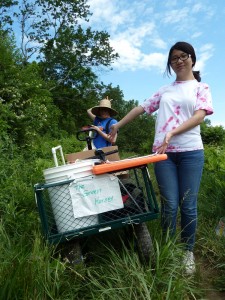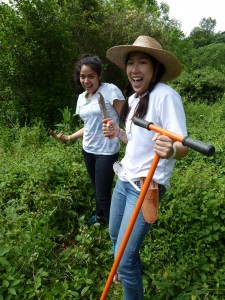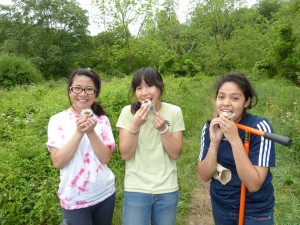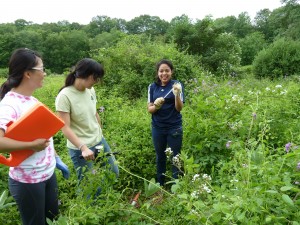Hello everyone! Last week was our final week of research on Dicty and it was most definitely bittersweet. Although Catherine and I are excited to have the rest of our summer, it seems that we may have successfully created transformants from our gene knockout project! We replaced the Dicty Nudix gene DDB_G0283315 (also known as DCP2) with a blasticidin resistance gene, which was a long but surprisingly easy process. Through the polymerase chain reaction (PCR) we amplified the right and left flanks around the DCP2 gene and cloned them into a bacterial plasmid surrounding the blasticidin resistance gene. The flanking regions of the DCP2 gene should promote homologous recombination in Dicty, allowing the DCP2 gene to be replaced with the blasticidin resistance gene. Blasticidin is an antibiotic lethal to many prokaryotes and eukaryotes and only Dicty cells that have the blasticidin gene in place of the gene to be knocked out should grow.
To insert this plasmid into our Dicty cells, we linearized the plasmid and then used an electroporator to shock the DNA into the cells. We then added these cells to media without blasticidin for a few days, and once they seemed to be growing again we started to add blasticidin to select for the Dicty DCP2 knockout. At first the results were not promising, because even our control plates seemed to be growing the same as the knockout plates. After about two weeks, there was a marked difference between the controls and the transformants. When Dicty is healthy, it will adhere to the bottom of a petri dish in liquid media. The control cells were most definitely dead because they were all floating and very small and round. The transformed cells from the DCP2 knockout had many floating and clumped cells yet areas of healthy cells growing as colonies. When we found these colonies, we were all very surprised! The presence of these colonies confirmed that blasticidin resistance had been conferred into our Dicty cells! None of us expected success in this experiment because the gene could be essential for the cells to survive and/or Dicty transformation is a notoriously difficult and long process. Needless to say, we are thrilled with our results, but much work still needs to be done to confirm our gene knockout.
We next wanted to isolate clonal populations of Dicty that had the DCP2 gene knocked out. To do this, we diluted the transformed cells and started to grow them on LP agar plates with B/r, a strain of E. coli bacteria. Dictyostelium eats bacteria in its natural habitat, the forest floor, so once our Dicty cells begin to consume the bacteria Dicty plaques will form on the plates. A plaque is a hole in the bacteria that is assumed to have been initiated by one Dicty cell, thereby producing a clonal knockout population. When the cells have eaten all of the available bacteria in the area, fruiting bodies will form which contain spores. Then we will isolate the sporeheads and begin growing them in regular media with blasticidin. Next, we will need to confirm the gene knockout by either PCR or Northern Blot. There is a possibility that the blasticidin resistance gene was put somewhere else into the genome rather than where the DCP2 gene is located, so while our cells seem to be blasticidin resistant, we cannot be completely certain of the knockout until further screening is done. Unfortunately I will not have time to screen these cells further, so Dr. Parrish will generously be coming in for the rest of the summer to finish the experiment. We all hope that the knockout is confirmed, but then we need to assess the consequence of the loss of this gene for Dicty cells. We will look at the effect on mRNA turnover in these knockout cells, since DCP2 encodes a putative mRNA decapping enzyme.
In the last week of research we performed a Northern Blot, which is a method to measure levels of gene expression during different times of development. As you learned in Catherine’s post, we performed a time course last week and harvested the cells at different stages in their development. After extracting RNA from the cells we ran a gel to resolve the RNA. The blotting part of the experiment involved placing a membrane under the gel and a weight so that the RNA was transferred onto the membrane. After this was finished, we treated the membrane with luminescent probes for the gene of interest and visualized the results by film development with autoradiography paper.


Unfortunately, our film did not turn out as desired but this is most likely due to a problem with the blotting procedure. There was a lot of background on the X-ray film, making the results hard to interpret. There may have been problems with the actual transfer of the RNA to the membrane or possible RNA degradation, yet in either instance the experiment must be repeated. Dr. Parrish and future research students will troubleshoot the experiment to receive better results.
Summer research was an invaluable experience that I will remember for the rest of my life. Although Catherine and I worked hard (most of the time), we had a ton of fun in the lab and kindled a new friendship. Dr. Parrish was wonderful with helping us get a better grasp of our projects and a better understanding of molecular biology in general. We hope that you enjoyed our posts and enjoyed learning more about Dictyostelium!
~Kirsten

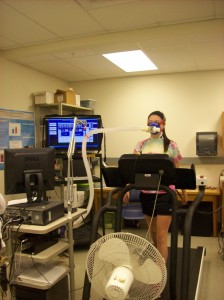

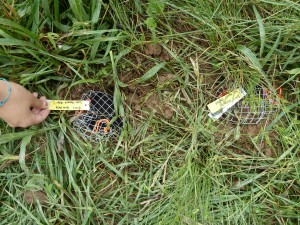 A total of 48 mesh traps were buried 3 inches in the soil in 6 different sites. There are two locations per site, one near the path and one away from the path. The near the path and away from the path mesh traps are filled with topsoil. Every sample has its own control mesh trap filled with regular soil. The purpose of the Soil re-colonization experiment is to determine the rate of re-colonization of invertebrates near the path and away from the path in order to verify if the path serves as a barrier for soil invertebrates. We hypothesize that the samples near the trail will have slower rate of re-colonization due to the disturbance of the path used by humans and horses. An early harvest will be collected in 5 days (Wed. 19 ) to determine the rate of re-colonization. A late harvest will be collected in 11 days (Mon. 24).
A total of 48 mesh traps were buried 3 inches in the soil in 6 different sites. There are two locations per site, one near the path and one away from the path. The near the path and away from the path mesh traps are filled with topsoil. Every sample has its own control mesh trap filled with regular soil. The purpose of the Soil re-colonization experiment is to determine the rate of re-colonization of invertebrates near the path and away from the path in order to verify if the path serves as a barrier for soil invertebrates. We hypothesize that the samples near the trail will have slower rate of re-colonization due to the disturbance of the path used by humans and horses. An early harvest will be collected in 5 days (Wed. 19 ) to determine the rate of re-colonization. A late harvest will be collected in 11 days (Mon. 24).